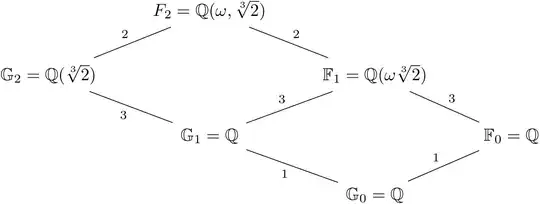The motivation for this is to generalize the constructible numbers to higher degrees than $2$. Complex square roots can be expressed in terms of real square roots.
Suppose we have an algebraic number $\alpha\in\mathbb R$, which is contained in a tower of fields (excuse the notation; these are not finite fields):
$$\alpha\in\mathbb F_m\supset\mathbb F_{m-1}\supset\cdots\supset\mathbb F_1\supset\mathbb F_0=\mathbb Q,$$
where all $m$ extensions $\mathbb F_{k+1}/\mathbb F_k$ have degree $3$ or $2$. This means each element of $\mathbb F_{k+1}$ can be expressed using addition, subtraction, multiplication, division, elements of $\mathbb F_k$, and a single element not in $\mathbb F_k$ which solves a cubic equation with coefficients in $\mathbb F_k$. (Anything solving a quadratic equation $x^2+ax+b=0$ also solves a cubic equation $x^3+ax^2+bx=0$.)
These are sub-fields of $\mathbb C$. Must there be such a tower of sub-fields of $\mathbb R$?
One possibility is to simply take $\mathbb G_k=\mathbb F_k\cap\mathbb R$, so that
$$\alpha\in\mathbb G_m\supseteq\mathbb G_{m-1}\supseteq\cdots\supseteq\mathbb G_1\supseteq\mathbb G_0=\mathbb Q;$$
then we only need to show that each extension has degree $\leq3$ (or can be expanded into a sub-tower with degrees $\leq3$). Clearly if $\mathbb F_k\subset\mathbb R$, then $\mathbb G_k=\mathbb F_k$ and $[\mathbb G_{k+1}:\mathbb G_k]\leq[\mathbb F_{k+1}:\mathbb G_{k+1}][\mathbb G_{k+1}:\mathbb G_k]=[\mathbb F_{k+1}:\mathbb F_k]\leq3$. So we need to consider the extensions $\mathbb G_{k+1}/\mathbb G_k$ where $\mathbb F_k\not\subset\mathbb R$.
Here's an illustration of an example, with $\omega=\frac{-1+\sqrt{-3}}2\not\in\mathbb R$ and $\alpha=\sqrt[3]2\in\mathbb R$:
The diagonal lines denote extensions. Notice that $[\mathbb G_2:\mathbb G_1]=3\not\leq2=[\mathbb F_2:\mathbb F_1]$.
Any real solution of a real cubic equation can be expressed using complex cube roots (and square roots). In the irreducible case, the solutions cannot be expressed using real cube roots. These solutions are allowed here; I'm not requiring radical extensions.
If $\alpha$ is quartic over $\mathbb Q$, then it can be expressed using real solutions of cubic equations, as shown here.
